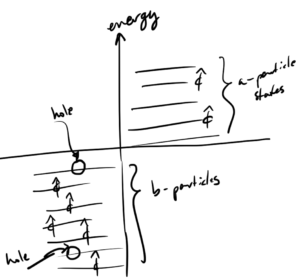[Click here for a PDF of this post with nicer formatting]
We found that the solution of the \( u(p), v(p) \) matrices were
\begin{equation}\label{eqn:DiracUVmatricesExplicit:20}
\begin{aligned}
u(p) &=
\begin{bmatrix}
\sqrt{p \cdot \sigma} \zeta \\
\sqrt{p \cdot \overline{\sigma}} \zeta \\
\end{bmatrix} \\
v(p) &=
\begin{bmatrix}
\sqrt{p \cdot \sigma} \eta \\
-\sqrt{p \cdot \overline{\sigma}} \eta \\
\end{bmatrix},
\end{aligned}
\end{equation}
where
\begin{equation}\label{eqn:DiracUVmatricesExplicit:40}
\begin{aligned}
p \cdot \sigma &= p_0 \sigma_0 – \Bsigma \cdot \Bp \\
p \cdot \overline{\sigma} &= p_0 \sigma_0 + \Bsigma \cdot \Bp.
\end{aligned}
\end{equation}
It was pointed out that these square roots can be conceptualized as (in the right basis) as the diagonal matrices of the eigenvalue square roots.
It was also pointed out that we don’t tend to need the explicit form of these square roots.We saw that to be the case in all our calculations, where these always showed up in the end in quadratic combinations like \( \sqrt{ (p \cdot \sigma)^2 }, \sqrt{ (p \cdot \sigma)(p \cdot \overline{\sigma})}, \cdots \), which nicely reduced each time without requiring the matrix roots.
I encountered a case where it would have been nice to have the explicit representation. In particular, I wanted to use Mathematica to symbolically expand \( \overline{\Psi} i \gamma^\mu \partial_\mu \Psi \) in terms of \( a^s_\Bp, b^r_\Bp, \cdots \) representation, to verify that the massless Dirac Lagrangian are in fact the energy and momentum operators (and to compare to the explicit form of the momentum operator found in eq. 3.105 [1]). For that mechanical task, I needed explicit representations of all the \( u^s(p), v^r(p) \) matrices to plug in.
It happens that \( 2 \times 2 \) matrices can be square-rooted symbolically (FIXME: link to squarerootOfFourSigmaDotP.nb notebook). In particular, the matrices \( p \cdot \sigma, p \cdot \overline{\sigma} \) have nice simple eigenvalues \( \pm \Norm{\Bp} + \omega_\Bp \). The corresponding unnormalized eigenvectors for \( p \cdot \sigma \) are
\begin{equation}\label{eqn:DiracUVmatricesExplicit:60}
\begin{aligned}
e_1 &=
\begin{bmatrix}
– p_x + i p_y \\
p_z + \Norm{\Bp}
\end{bmatrix} \\
e_1 &=
\begin{bmatrix}
– p_x + i p_y \\
p_z – \Norm{\Bp}
\end{bmatrix}.
\end{aligned}
\end{equation}
This means that we can diagonalize \( p \cdot \sigma \) as
\begin{equation}\label{eqn:DiracUVmatricesExplicit:80}
p \cdot \sigma
= U
\begin{bmatrix}
\omega_\Bp+ \Norm{\Bp} & 0 \\
0 & \omega_\Bp- \Norm{\Bp}
\end{bmatrix}
U^\dagger,
\end{equation}
where \( U \) is the matrix of the normalized eigenvectors
\begin{equation}\label{eqn:DiracUVmatricesExplicit:100}
U =
\begin{bmatrix}
e_1′ & e_2′
\end{bmatrix}
=
\inv{ \sqrt{ 2 \Bp^2 + 2 p_z \Norm{\Bp} } }
\begin{bmatrix}
-p_x + i p_y & -p_x + i p_y \\
p_z + \Norm{\Bp} & p_z – \Norm{\Bp}
\end{bmatrix}.
\end{equation}
Letting Mathematica churn through the matrix products \ref{eqn:DiracUVmatricesExplicit:80} verifies the diagonalization, and for the roots, we find
\begin{equation}\label{eqn:DiracUVmatricesExplicit:120}
\sqrt{ p \cdot \sigma }
=
\inv{
\sqrt{ \omega_\Bp- \Norm{\Bp} } + \sqrt{ \omega_\Bp+ \Norm{\Bp} }
}
\begin{bmatrix}
\omega_\Bp- p_z + \sqrt{ \omega_\Bp^2 – \Bp^2 } & – p_x + i p_y \\
– p_x – i p_y & \omega_\Bp+ p_z + \sqrt{ \omega_\Bp^2 – \Bp^2 }
\end{bmatrix}.
\end{equation}
Now we can plug in \( \zeta^{1\T} = (1,0), \zeta^{2\T} = (0,1), \eta^{1\T} = (1,0), \eta^{2\T} = (0,1) \) to find the explicit form of our \( u\)’s and \( v\)’s
\begin{equation}\label{eqn:DiracUVmatricesExplicit:140}
\begin{aligned}
u^1(p) &=
\inv{
\sqrt{ \omega_\Bp- \Norm{\Bp} } + \sqrt{ \omega_\Bp+ \Norm{\Bp} }
}
\begin{bmatrix}
\omega_\Bp- p_z + \sqrt{ \omega_\Bp^2 – \Bp^2 } \\
– p_x – i p_y \\
\omega_\Bp+ p_z + \sqrt{ \omega_\Bp^2 – \Bp^2 } \\
p_x + i p_y \\
\end{bmatrix} \\
u^2(p) &=
\inv{
\sqrt{ \omega_\Bp- \Norm{\Bp} } + \sqrt{ \omega_\Bp+ \Norm{\Bp} }
}
\begin{bmatrix}
– p_x + i p_y \\
\omega_\Bp+ p_z + \sqrt{ \omega_\Bp^2 – \Bp^2 } \\
p_x – i p_y \\
\omega_\Bp- p_z + \sqrt{ \omega_\Bp^2 – \Bp^2 } \\
\end{bmatrix} \\
v^1(p) &=
\inv{
\sqrt{ \omega_\Bp- \Norm{\Bp} } + \sqrt{ \omega_\Bp+ \Norm{\Bp} }
}
\begin{bmatrix}
\omega_\Bp- p_z + \sqrt{ \omega_\Bp^2 – \Bp^2 } \\
– p_x – i p_y \\
-\omega_\Bp- p_z + \sqrt{ \omega_\Bp^2 – \Bp^2 } \\
-p_x – i p_y \\
\end{bmatrix} \\
v^2(p) &=
\inv{
\sqrt{ \omega_\Bp- \Norm{\Bp} } + \sqrt{ \omega_\Bp+ \Norm{\Bp} }
}
\begin{bmatrix}
– p_x + i p_y \\
\omega_\Bp+ p_z + \sqrt{ \omega_\Bp^2 – \Bp^2 } \\
-p_x + i p_y \\
-\omega_\Bp+ p_z + \sqrt{ \omega_\Bp^2 – \Bp^2 } \\
\end{bmatrix}.
\end{aligned}
\end{equation}
This is now a convenient form to try the next symbolic manipulation task. If nothing else this takes some of the mystery out of the original compact notation, since we see that the \( u,v \)’s are just \( 4 \) element column vectors, and we know their explicit should we want them.
Also note that in class we made a note that we should take the positive roots of the eigenvalue diagonal matrix. It doesn’t look like that is really required. We need not even use the same sign for each root. Squaring the resulting matrix root in the end will recover the original \( p \cdot \sigma \) matrix.
References
[1] Michael E Peskin and Daniel V Schroeder. An introduction to Quantum Field Theory. Westview, 1995.
